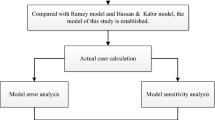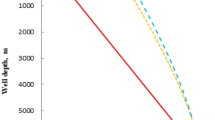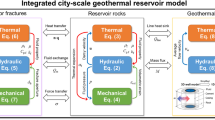Abstract
In the production process of high-temperature and high-pressure gas wells, it is very important to understand the changes of the temperature and pressure parameters in the wellbore with the depth of the well. Based on the conservation of fluid energy, momentum, and mass in the wellbore, considering the influence of high-temperature and high-pressure gas wells on the temperature and pressure of the wellbore under the coupling of fluid velocity, density, and Joule–Thomson effect, a wellbore temperature and pressure prediction model was established based on this. Then, we could obtain wellbore temperature and pressure distribution along the well depth. The comparison with the actual wellbore data of Tarim X gas well and XX well in Southwest China shows that the calculation result of the multifactor coupling model is less than 3% of the field measured data, which verifies the accuracy of the multifactor coupling model result. Based on this, the effects of different gas production and production time on the temperature and pressure of high-temperature and high-pressure gas well boreholes were analyzed. The results show that for the Tarim X gas well, when the gas production is 80 × 104, 90 × 104 and 100 × 104 m3/day, the corresponding wellhead temperatures are 56.1, 65.3, and 69.8 °C; the corresponding wellhead pressures are 62.4, 62.2, and 62.0 MPa. When the production time is 1 day, 10 days, and 20 days, the corresponding wellhead temperatures are 61.5, 63.6, and 64.8 °C, respectively; the corresponding wellhead pressures are 63, 62.8, and 62.4 MPa.








Similar content being viewed by others
Abbreviations
- E :
-
The internal energy of a gas fluid (J)
- m :
-
The mass of a gas fluid (kg)
- g :
-
Acceleration of gravity (9.8 m/s2)
- v :
-
The average velocity of gas and fluid on the horizontal plane (m/s)
- p :
-
The pressure of gas fluid (Pa)
- V :
-
The volume of gas and fluid (m3)
- Q :
-
Microelement wellbore heat loss (J/m s)
- H :
-
Specific enthalpy (J/kg)
- h :
-
Well bore length (m)
- ρ :
-
Fluid density (kg/m3)
- f :
-
Friction coefficient of tubing inner wall (dimensionless)
- d :
-
The tubing diameter (m)
- r yo :
-
Tubing outer diameter (m)
- U to :
-
Total heat transfer coefficient from fluid to cement ring (W/m °C)
- T l :
-
Fluid temperature (°C)
- w :
-
Mass flow rate (kg/s)
- A :
-
Fluid cross section area (m2)
- λ e :
-
Formation thermal conductivity (W/m °C)
- T e :
-
Formation temperature (°C)
- f(tD):
-
Dimensionless time function
- z :
-
Vertical depth (m)
- C p :
-
Constant pressure specific volume of a gas fluid (J/kg °C)
- η :
-
Joule–Thomson coefficient (°C/pa)
- r g :
-
Relative density
- M g :
-
Average molecular weight of natural gas (kg/mol)
- R :
-
Ideal gas constant
- r hk :
-
Distance from the axis of the wellbore to outer edge of the k annulus (m)
- λ hk :
-
The k annulus heat transfer coefficient (W/m °C)
- r goi :
-
Outer radius of the i casing layer (m)
- r gi :
-
Radius of the i layer (m)
- \(r_{sox}\) :
-
Outer radius of the x casing layer (m)
- r sx :
-
Radius of the x layer (m)
- λ gi :
-
Heat transfer coefficient of the i layer of casing (W/m °C)
- λ sx :
-
Heat transfer coefficient of layer x cement ring (W/m·°C)
- r yi :
-
Tubing diameter (m)
- ζ:
-
Wall roughness (m)
- Re :
-
Gas Reynolds number
- p ci :
-
Critical pressure of the i component of natural gas (Pa)
- T ci :
-
Critical pressure of the i component in natural gas (°C)
References
J. Yang, Fundamentals of gas production process (Petroleum Industry Press, Beijing, 1992)
M. Schlumberger, A.A. Perebinossoff, H.G. Doll, Temperature measurements in oil wells. J. Pet. Technol. 23, 159 (1937)
H.J. Ramey, Wellbore heat transmission. J. Pet. Technol. 14(4), 427–435 (1962)
A. Satter, Heat losses during flow of steam down a wellbore. J. Pet. Technol. 17(7), 845–851 (1965)
G.P. Willhite, Over-all heat transfer coefficients in steam and hot water injection wells. J. Pet. Technol. 19(5), 607–615 (1967)
K.C. Shiu, H.D. Beggs, Predicting temperatures in flowing oil wells. J. Energy Res. Technol. 10(1), 2–11 (1980)
R. Sagar, D.R. Doty, Z. Schmidt, Predicting temperature profiles in a flowing well. SPE Prod. Eng. 6(4), 441–448 (1991)
Seth G, Reynolds AC, Mahadevan J (2010) Numerical model for interpretation of distributed-temperature-sensor data during hydraulic fracturing. In: SPE135603-MS, this paper presented at SPE annual technical conference and exhibition, 19–22 September, Florence, Italy
Hasan AR, Kabir CS (1991) Heat transfer during two-Phase flow in wellbores; part I-formation temperature. In: SPE annual technical conference and exhibition. Society of Petroleum Engineers, pp 469–478
Y. Zhang, L. Pan, K. Pruess, A time-convolution approach for modeling heat exchange beten a wellbore and surrounding formation. Geothermics 40(4), 261–266 (2001)
J. Hagoort, Ramey’s wellbore heat transmission revisited. SPE J 9(04), 465–474 (2004)
H.N. Hoang, J. Mahadevan, H. Lopez, Injection profiling during limited-entry fracturing using distributed-temperature-sensor data. SPE J 17(3), 752–767 (2012)
B. Izgec, C.S. Kabir, D. Zhu, A.R. Hasan, Transient fluid and heat flow modeling in coupled wellbore/reservoir systems. SPE Reserv Eval Eng 10(3), 294–301 (2007)
A.R. Hasan, C.S. Kabir, X. Wang, A robust steady-state model for flowing-fluid temperature in complex wells. SPE Prod. Oper. 24(2), 269–272 (2009)
Seth G, Reynolds AC, Mahadevan J (2010) Numerical model for interpretation of distributed-temperature-sensor data during hydraulic fracturing. SPE135603-MS, this paper presented at SPE annual technical conference and exhibition, 19–22 September, Florence, Italy
X.-W. Liao, J.-L. Feng, Pressure-temperature coupling calculation of transient wellbore heat transfer in deep geopressured gas reservoir. Pet. Explor. Dev. 32(1), 67–69 (2005)
Acknowledgments
This project was supported by the Natural Science Foundation of Shaan Xi Province in 2019 (No. 2019JQ-825) and (No. 2019JQ-755) and the Natural Science Foundation of Shaanxi Provincial Department of Education in 2019 (19JK0462).
Author information
Authors and Affiliations
Corresponding author
Additional information
Publisher's Note
Springer Nature remains neutral with regard to jurisdictional claims in published maps and institutional affiliations.
Rights and permissions
About this article
Cite this article
Zheng, J., Dou, Yh., Cao, Y. et al. Prediction and Analysis of Wellbore Temperature and Pressure of HTHP Gas Wells Considering Multifactor Coupling. J Fail. Anal. and Preven. 20, 137–144 (2020). https://doi.org/10.1007/s11668-020-00811-2
Received:
Published:
Issue Date:
DOI: https://doi.org/10.1007/s11668-020-00811-2




